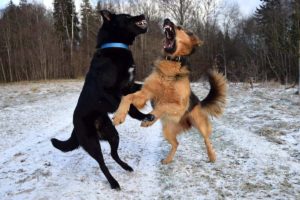
Aggression is known to be an innate canine behavior. It can be a normal response to a particular situation that’s new to them. A dog’s aggression could mean a lot of things, such as being territorial, possessive, defensive, unsocialized, being in pain.
Experiencing this hostile attitude from your pet can be frightening, but as an owner, it’s essential to deal with it sooner because it may lead to a completely out-of-control dog when the behavior is neglected. It’s quite challenging to manage an aggressive dog, especially if you’re not an expert. Take note of the considerations below so you can deal with them peacefully and safely.
Talk To A Reputable Dog Behaviorist
If an aggressive dog has bitten a person, it’s an indication that you shouldn’t take their behavior lightly. In this case, authorities may intervene, and they may require someone qualified to reinforce good behavior to your pet, which is where a dog behaviorist or a pet psychologist comes in. These professionals help you gain in-depth knowledge about your pet’s dispositions and temperaments and uses psychology to modify that behavior to make the situation less stressful and dangerous.
Dog trainers and dog behaviorists are often interchanged. Dog trainers make use of training methods to instill a particular behavior into your pet. In comparison, a dog behaviorist focuses more on studying their behavior and the factors that may significantly affect behavioral change. It’s important to search for a certified dog behaviorist because anyone can claim that they’re experts. To ensure that your pet is in good hands, check their credentials.
2. Identify The Cause Of Aggression
To come up with a possible plan to solve your dog’s aggressiveness, you must first know the root cause of such behavior. It’s unusual for dogs to be violent out of nowhere; that’s why you need to pay attention to what their actions imply. In most cases, it could be related to their being territorial or dominant, lack of socialization, or as a way to display fear, anxiety, and pain. By knowing the reason which triggers this issue, you can easily find the best options to correct their behavior.
Take note of what caused the change in their mood. Did your dog growl at other dogs? Did a stranger go near them? Was your dog standing in front of you in an attempt to protect you? If it’s the first time you see your dog act strange, even towards you, your priority is everyone’s safety, especially if you have kids. You can leash them or confine them in one corner until you figure out the cause of aggression.
3. Consult Your Vet
If your dog is usually friendly or docile, there’s a possibility that the reason your dog suddenly becomes aggressive is due to a medical problem or an injury. There’s no effective training to deal with the aggression until the underlying issue is resolved. Medical conditions such as arthritis, hip dysplasia, brain tumors, epilepsy, and other neurological disorders usually cause grumpiness in dogs.
When you suspect that your dog may be experiencing pain, only a veterinarian can diagnose their condition precisely and can give you the right medications to alleviate their pain. Treating which causes their discomfort may help lessen irritability and may, later on, rule out aggression. In extreme cases, your vet may sedate your dog with an FDA-approved drug if they need to administer a diagnostic procedure that requires them to stay calm.
4. Avoid Punishment
In most cases, dogs display aggressive behavior as a way of communicating that they’re anxious, nervous, or tense. Punishing them by hitting or yelling may give them the feeling that they need to protect themselves, so they bite you in return. Punishment aggravates the situation because the more fear your dog experiences, the more aggressive they become.
Dogs don’t understand punishment, but they can easily sense if you’re angry, so it’s essential to stay calm yet assertive. A way to train them for their aggressive behavior is through reward-based training. The use of positive reinforcement rewards good behavior and ignores the unwanted behavior of the dog. For the reward-based training to be effective, you can reward your dog depending on what they enjoy—tasty treats, cuddles, or verbal praise.
Final Thoughts
Addressing your dog’s aggressive behavior not only protects yourself and the people around you during an aggressive outburst, but it’ll ensure your pet’s health and safety as well. If you have an aggressive dog, it’s imperative to identify such behavior’s root cause to eliminate the triggers. Don’t resort to giving punishments.
To better deal with your dog’s behavior, you may ask help from a veterinarian or a dog behaviorist; they’re the right professionals who can better understand what your dog is going through.






